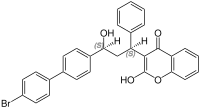Bromadiolone
| Structural formula | |||||||||||||||||||
|---|---|---|---|---|---|---|---|---|---|---|---|---|---|---|---|---|---|---|---|

|
|||||||||||||||||||
| Basic structural formula (stereocenters are marked with an * ) | |||||||||||||||||||
| General | |||||||||||||||||||
| Surname | Bromadiolone | ||||||||||||||||||
| other names |
|
||||||||||||||||||
| Molecular formula | C 30 H 23 BrO 4 | ||||||||||||||||||
| Brief description |
colorless and odorless solid |
||||||||||||||||||
| External identifiers / databases | |||||||||||||||||||
|
|||||||||||||||||||
| properties | |||||||||||||||||||
| Molar mass | 527.41 g mol −1 | ||||||||||||||||||
| Physical state |
firmly |
||||||||||||||||||
| density |
0.32 g cm −3 |
||||||||||||||||||
| Melting point |
200 - 210 ° C (mixture of isomers) |
||||||||||||||||||
| solubility |
|
||||||||||||||||||
| safety instructions | |||||||||||||||||||
|
|||||||||||||||||||
| Toxicological data | |||||||||||||||||||
| As far as possible and customary, SI units are used. Unless otherwise noted, the data given apply to standard conditions . | |||||||||||||||||||
Bromadiolone is a mixture of four stereoisomeric chemical compounds from the group of coumarin derivatives . It is used as a rodenticide .
properties
Bromadiolone is a white to yellowish solid that is sparingly soluble in water. The technical product is a mixture of two diastereomers with at least 97% purity.
Stereoisomers
The active ingredient contains two stereocenters and this results in four different stereoisomers :
- (1 R , 3 S ) - (4'-Hydroxy-3'-coumarinyl) -3-phenyl-1- (4'-bromobiphenyl) -1-propanol
- (1 S , 3 R ) - (4'-Hydroxy-3'-coumarinyl) -3-phenyl-1- (4'-bromobiphenyl) -1-propanol
- (1 R , 3 R ) - (4'-Hydroxy-3'-coumarinyl) -3-phenyl-1- (4'-bromobiphenyl) -1-propanol
- (1 S , 3 S ) - (4'-Hydroxy-3'-coumarinyl) -3-phenyl-1- (4'-bromobiphenyl) -1-propanol
The (1 R , 3 S ) -isomer and the (1 S , 3 R ) -isomer are diastereoisomers of the (1 R , 3 R ) - and (1 S , 3 S ) -configured isomers. The former are known as trans -bromadiolone and are about 70-90% in the mixture. The (1 R , 3 R ) - and (1 S , 3 S ) -configured isomers are referred to as cis -bromadiolone, which is about 10-30% in the mixture of the rodenticide.
| Bromadiolone |
|
|---|---|
 (1 R , 3 S ) isomer |
 (1 S , 3 R ) isomer |
 (1 R , 3 R ) isomer |
 (1 S , 3 S ) isomer |
use
Bromadiolone is used as a rodenticide . It is a second generation anticoagulant and is mainly used as a feeding bait in communal and agricultural rat control. It works by inhibiting prothrombin formation and is usually used in a concentration of 0.005%. It was patented as a rodenticide in 1967.
Admission
As a biocidal product
According to European legislation (Directive 98/8 / EC on the placing of biocidal products on the market) and with the resolution of July 31, 2009, a decision has been made to add the active ingredient bromadiolone to the corresponding list (Appendix I / IA of Directive 98/8 / EC ) for product type 14 (rodenticides). The sale of biocidal products containing the active ingredient bromadiolone is therefore still permitted in the EU ( Switzerland has adopted this provision). However, this permit was subject to certain conditions:
- The nominal concentration of the active ingredient in the products must not exceed 50 mg / kg and only ready-to-use products may be approved. The products must not be used as an adhesive poison.
- Appropriate measures must be implemented to reduce the risk to humans, non-target animals and the environment. For example, the restriction to use by specialist staff, the definition of a maximum package size and the obligation to use secure, stable bait boxes.
- The approval was initially limited to June 30, 2016 and an extension was linked to a new risk assessment.
With the implementation decision 2015/1737, the expiry date was postponed to June 30, 2018. The risk assessment allowed an extension of the approval, which was implemented with the implementation regulation 2017/1380. The above restrictions still apply. Also:
- Depending on the area of application, a maximum of 300 g of bait may be sold per package,
- the use for certain purposes is only permitted in buildings,
- must be accompanied by information about the risks.
Approval was granted until June 30, 2024 .
As a pesticide
In accordance with European legislation (Directive 91/414 / EEC of July 15, 1991 on the placing of plant protection products on the market) and with a resolution of December 8, 2008 of the EU Commission, it was decided not to include the active ingredient bromadiolone in Annex I of Directive 91/414 / EEC (positive list of the active substances permitted in plant protection products). The sale of pesticides containing the active ingredient bromadiolone would no longer have been allowed from 2012. This resolution was repealed by a decision of April 15, 2011. The EU member states can re-authorize plant protection products with the active ingredient bromadiolone, provided they comply with various statutory conditions and test procedures.
In Switzerland, the active ingredient bromadiolone is also listed in Appendix 1 (approved active ingredients) of the Plant Protection Ordinance.
In Switzerland, bromadiolone is contained in preparations against rats. No pesticides containing this active ingredient are permitted in Austria or Germany.
Individual evidence
- ↑ a b c d e f g h Entry on bromadiolone in the GESTIS substance database of the IFA , accessed on January 10, 2017(JavaScript required) .
- ^ M. Bahadir, H. Parlar, Michael Spiteller (eds.): Springer Umweltlexikon . 2nd Edition. Springer-Verlag, Berlin / Heidelberg 2013, ISBN 978-3-642-56998-2 , p. 236 ( limited preview in Google Book search).
- ↑ a b c d Robert Irving Krieger: Handbook of Pesticide Toxicology: Principles ; ISBN 978-0-12-426260-7 , p. 1822 ( limited preview in Google book search).
- ↑ entry on bromadiolone (ISO); 3- [3- (4'-bromobiphenyl-4-yl) -3-hydroxy-1-phenylpropyl] -4-hydroxy-2H-chromen-2-one in the Classification and Labeling Inventory of the European Chemicals Agency (ECHA), accessed on June 17, 2017. Manufacturers or distributors can expand the harmonized classification and labeling .
- ↑ Entry on bromadiolone. In: Römpp Online . Georg Thieme Verlag, accessed on June 10, 2017.
- ↑ I. Fourel, M. Damin-Pernik, E. Benoit, V. Lattard: Cis-Bromadiolone diastereoisomeric is not involved in Bromadiolone Red Kite (Milvus milvus) poisoning. In: Science of The Total Environment . 601–602, 2017, pp. 1412–1417, doi: 10.1016 / j.scitotenv.2017.06.011 .
- ↑ Rodenticides. Federal Environment Agency , December 5, 2013, accessed June 10, 2017 .
- ↑ EU: Directive 98/8 / EC of February 16, 1998 on the placing of biocidal products on the market (PDF) Official Journal of the European Communities L 123/1 of April 24, 1998.
- ↑ EU: Directive 2009/92 / EC of July 31, 2009 amending Directive 98/8 / EC to include bromadiolone in Appendix I (PDF) Official Journal of the European Communities L 201/43 of August 1, 2009.
- ↑ IMPLEMENTING DECISION (EU) 2015/1737 OF THE COMMISSION of 28 September 2015 to postpone the expiry date of the approval of bromadiolone, chlorophacinone and coumatetralyl for use in biocidal products of product type 14
- ↑ Implementing Regulation (EU) 2017/1380 of the Commission of July 25, 2017 for the renewal of the approval for bromadiolone as an active ingredient for use in biocidal products of product type 14 (PDF; 343 KB) In: eur-lex.europa.eu. July 24, 2017, accessed October 15, 2019 .
- ↑ EU: Directive 91/414 / EEC on the placing of plant protection products on the market (PDF; 1.1 MB) ABl. L 230 of 19 August 1991, p. 1.
- ↑ EU: Decision (2008/941 / EG) on the non-inclusion of certain active substances in Annex I of Directive 91/414 / EEC and revocation of the approvals for plant protection products (PDF) Official Journal of the European Communities L 335/91 of December 13, 2008.
- ↑ EU: Implementing Directive 2011/48 / EU amending Directive 91/414 / EEC to include the active substance bromadiolone (PDF) Official Journal of the European Communities L 102/28 of April 16, 2011.
- ↑ CH: Plant Protection Products Ordinance (PDF; 564 kB) SR 916.161 - valid from July 1, 2011.
- ↑ General Directorate Health and Food Safety of the European Commission: Entry on Bromadiolone in the EU pesticide database; Entry in the national registers of plant protection products in Switzerland , Austria and Germany ; accessed on March 12, 2016 ..



